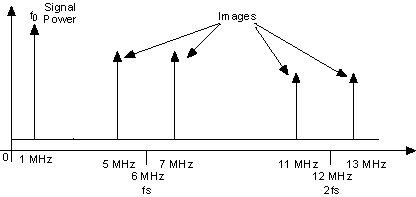Aliased Images
An aliased image is a frequency component that appears in continuous time waveforms being re–created from discrete–time, digital waveforms. The frequencies where these extra components appear are related to both the frequency of the signals being re–created as well as the frequency of the sample rate. Looking only at positive frequencies, the two frequencies are related by the following equation:
fai = |fo + nfs|
where
fai = the aliased images
fo = the desired waveform frequency
fs = the sample rate
n = an integer (either positive or negative)
As the equation indicates, there are an infinite number of these aliased images that occur although. As n gets larger, however, the power content of these extra frequencies "falls off."
The following figure shows a 1 MHz sine wave generated by a 6 MS/s DAC. The dotted line represents an aliased image signal that shows up as a 5 MHz component. In this case, fo is 1 MHz, n is –1, and fs is 6 MHz; resulting in the following formula:
fai = 5 MHz = |1 MHz + (–1)(6 MHz)|
The other possible frequencies of sine waves can be calculated and superimposed onto the sampling points of the image.

The following figure shows the frequency domain representation of the previous example. The vertical arrow at fo represents the frequency and signal power of the desired generated signal. The other vertical arrows represent the frequencies and signal powers of the aliased image frequency components that appear in the frequency spectrum.

In systems where you want to generate accurate signals using sampled data, an optional lowpass filter must be introduced after the DAC to restrict the bandwidth of the output signal to meet the sampling criteria (Shannon's Sampling theorem). For more information about filtering, refer to Filtering and Interpolation.